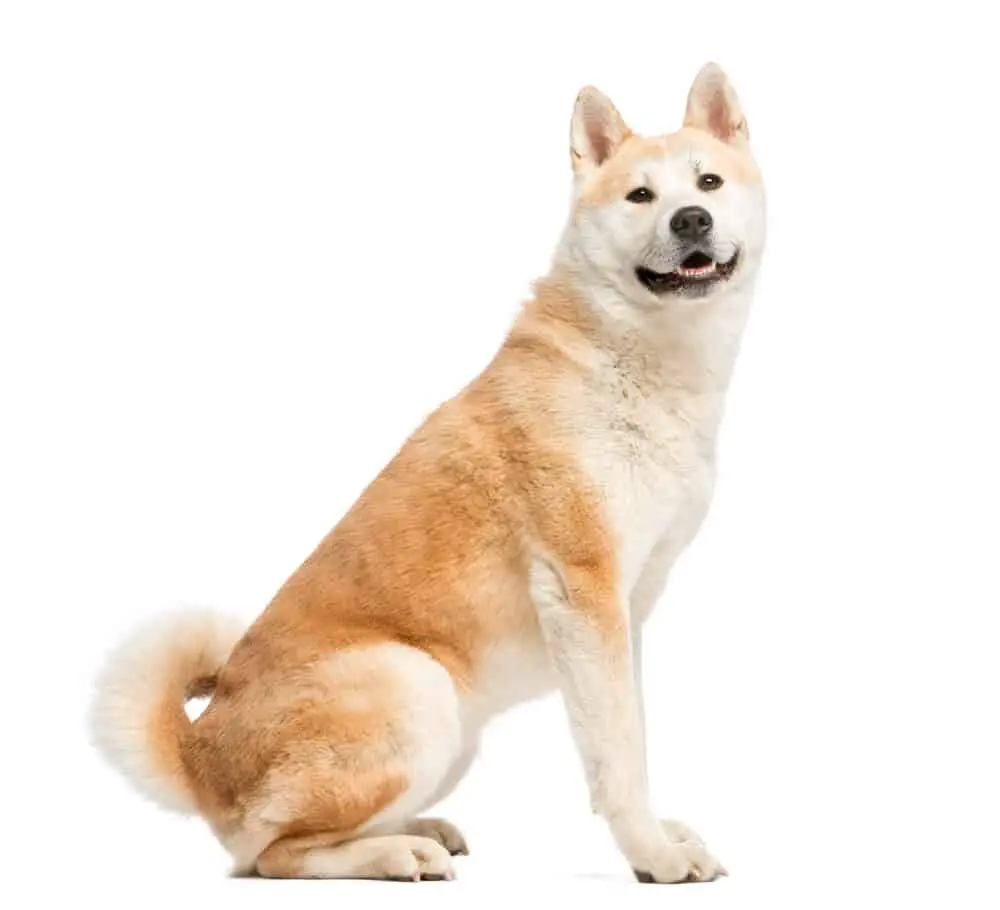Akita dogs are seen as a symbol of protection and used as police dogs in Japan.
Other Names: Akita Inu, Japanese Akita
Country Of Origin: Japan
Dog Group: Utility
Size: Large
Recommended For: Couples, single owners
Maintenance Level: Low
Lifespan: 10-12 years
Temperament: Loyal, affectionate, aloof
Common Akita Questions and Answers
Good For the First-Time Owner? No
Good With Children? Yes
Good With Other Animals? No
Good With Strangers? No
Good For Apartments? No
Exercise Requirements? Daily walks
Can Live In Hot Weather? No
Can Live In Cold Weather? Yes
Can Tolerate Being Left Alone? Yes
Grooming? Weekly brushing
Trainability? Moderate
Breed Overview:
Akitas originated from northern Japan and were bred for use in the mountains.
There are two types- Japanese and American, and both are recognized separately.
Originally bred for hunting, they were kept as companion pets for hundreds of years.
They like to be kept as pets and can be aggressive toward other dogs and small children.
Color: All colors are allowed by kennel clubs, and the breed is most commonly found in brindle, pinto, white, or any mix of the above.
Coat length: Medium, double-layered
Height: Males – 26-28,” females – 24-26.”
Weight: Males – 110lbs, females – 80lbs
Personality And Temperament:
The breeds are naturally very independent and were bred to live alone rather than in groups.
This is a trait that’s still present; as a result, dogs can be temperamental around other animals.
Helpful Link: Are Akitas Good With Cats?
However, if they’re socialized from an early age, you have a much better chance of them being tolerant of other dogs.
Even if you socialize with them, Akitas will try to dominate any animal group.
The breed isn’t suitable for first-time owners because it can be quite challenging to control.
They’re quite large dogs, and because of their heritage as bear hunters, they’re also powerful.
Their intelligence means they’re reasonably hard to train if you’re not committed, and the breed has regularly been known to get bored of training.
Generally, Akitas are very aloof and can be wary of strangers.
This is again because of their nature, and although you might be able to train them to tolerate strangers, they should still be walked with caution.
Many Akita owners don’t let them off the lead while walking to prevent any issues.
Akitas ideally shouldn’t be kept in apartments because they’re too energetic.
They’re known to have cat-like temperaments when it comes to sleeping but can also bounce off the walls with energy.
While you can keep them in apartments, you should only do so if you’re committed to giving them plenty of exercise, which they need plenty of anyway.
Akitas should be walked every day, typically for a few hours. The breed needs plenty of mental and physical stimulation, and many owners take them out for several walks a day to give them enough exercise.
Considering their attitude towards other dogs, this cannot be easy if you live in an urban area and have many other owners to contend with.
Regarding potential owners, Akitas are suitable for almost anyone with dog-keeping experience.
If you live alone and are considering getting an Akita, be aware of the breed’s exercise needs, as you’ll have to manage independently.
Thinking between Akita or Shiba?
The link below will help you choose which one is right for you:
The breed is fine to be kept with children, including young children, but the dog should be integrated into the family as early as possible.
They can tolerate accidentally aggressive behavior from children, but owners should be wary because the breed tends to snap if alerted.
For the same reason, Akitas make excellent guard dogs. They’re very wary of noise and are large enough to intimidate most intruders.
They bark at small noises, which can be both a blessing and a curse depending on the context.
It’s also worth noting that Akitas are an immaculate breed that can easily housetrain.
Due to their origins in the Japanese mountains, Akitas aren’t suitable for hot climates.
Their coats are thick and dense, so they can overheat quickly if not monitored.
They’re very similar to Huskies, so this should be used as an indicator of the pleasant climates for the breed. On the reverse of this, they’re ideal for colder climates and thrive in cold weather.
Akitas can tolerate being left alone for long periods, providing they have something to keep them entertained.
If not, the dog might become destructive, which is not ideal considering its size.
Although they can be difficult to train, starting early makes it much more comfortable, and the same is true for leaving them alone.
If you raise the dog and gradually leave it for extended periods, you’ll have a much better chance of success than if you start later.
Looking to train your dog in the Japanese language? –
Check out the Basic Japanese Dog Commands Article Now!
Grooming:
Akitas are generally very clean dogs and make much more effort to clean themselves than other breeds.
They tend to shed once or twice a year with seasonal changes, and during these times, they will produce a lot of hair.
However, they generally don’t shed for the rest of the year, so it’s quite tolerable.
It would be best if you brushed them around once a week to keep their coat in good condition.
It’s quite thick and so is prone to develop knots, although the dog will make its attempts to remove these.
A sturdy comb will make short work of any tangles or knots in their fur, but be very careful when combing out knots because they can be very painful.
Although their coat is very thick, their hairs are fine, particularly in their undercoat.
An easy way to deal with this is to spray the dog lightly with water from a spritzer bottle before brushing, but there’s no need to spray them too heavily.
You want their coat to be wet enough that the hairs stick together when combed out.
Akitas don’t need to be bathed too often because they do an excellent job of keeping themselves clean.
Their fur repels dirt, and the dog will quickly clean anything that does stick.
Also, because their coat is very thick, it takes a very long time to dry, and it isn’t easy to wash out any shampoo properly.
Save bathing for times when it’s essential, and if you think your dog might need a bath, spend a bit longer brushing them instead.
Common Diseases And Conditions:
Akitas are prone to autoimmune diseases, many of which will be present from birth.
They can be affected by autoimmune diseases relating to the skin, the blood, adrenal glands, and the thyroid.
If you’re buying a purebred Akita, these diseases will be much more likely, and it’s worth getting a health certificate for the dog before purchasing.
You can often manage these illnesses with medication, but they are incurable.
Akitas are also prone to diabetes, eye problems, such as retinal atrophy, vaccine sensitivity, and some medications, Cushing’s Syndrome, and hip dysplasia.
Again, these conditions will be more prevalent in purebred dogs, and many unfortunately begin in later life.
Your vet will know that Akitas are prone to these illnesses, so regular checkups are essential.
History:
In Japan, they recognized Akitas as one of the oldest native Japanese dog breeds and still hold a special place in the culture.
They were initially bred to hunt bears but have also been kept as companion pets and working dogs.
The first Akita was brought to America in 1937 by Helen Keller, who had visited Japan and expressed an interest in the breed.
However, the breed remained rare in the USA before and during World War 2, which impacted relations between the two countries.
During the war, Akitas nearly became extinct in Japan because they were used for food and clothing by the local populations.
After World War 2, American and Japanese Akitas began to differ, thanks to the desired breed standards in the different countries.
American Akitas usually have a more massive bone structure and bulkier heads, whereas Japanese Akitas tend to be slimmer and lighter.
American Akitas were first recognized as Miscellaneous Class in 1955 then recognized as Working Class by the American Kennel Club in 1972, and then recognized by the Japan Kennel Club in 1992.
The breed continued to be famous in Asia and other countries worldwide and was made even more prominent when featured in a meme in the mid-2000s.
RELATED ARTICLE: Dogs That Look Like Akitas
Akita Infographic
Did You Know?
- The breed has webbed toes that allow it to walk on snow without sinking.
- Akitas become much more energetic in cold weather and can happily spend all day in the snow.
- In Japan, the Akita is considered a national treasure, and statues are given to couples upon the birth of a child.
- Tails are one of the easiest identifiers of Akitas, and each dog has a different tail. This can be seen in its color, density, and curl.
- Akitas are known to clean themselves like cats do and require very little grooming.
-
Hachi: A Dog’s Tale movie is based on the true story of a faithful and most famous Akita Inu, Hachikō,
- Russian President Vladimir Putin has an Akita called Yume. It was given to him by Japan as thanks for Russian help during an earthquake. It was born in 2012, is still alive, and is kept at his official residence in Moscow.
- If you are looking for an Akita dog for sale, the price ranges from USD 750-2000.


